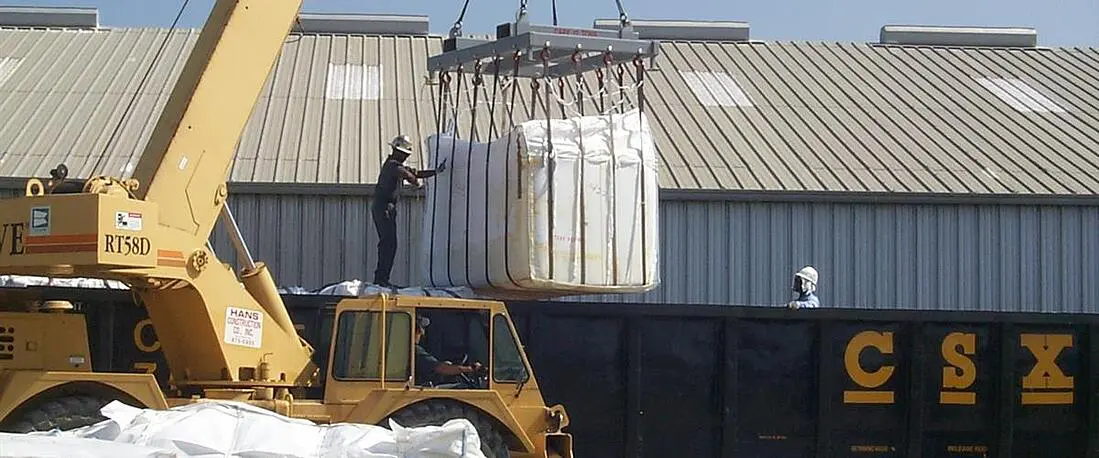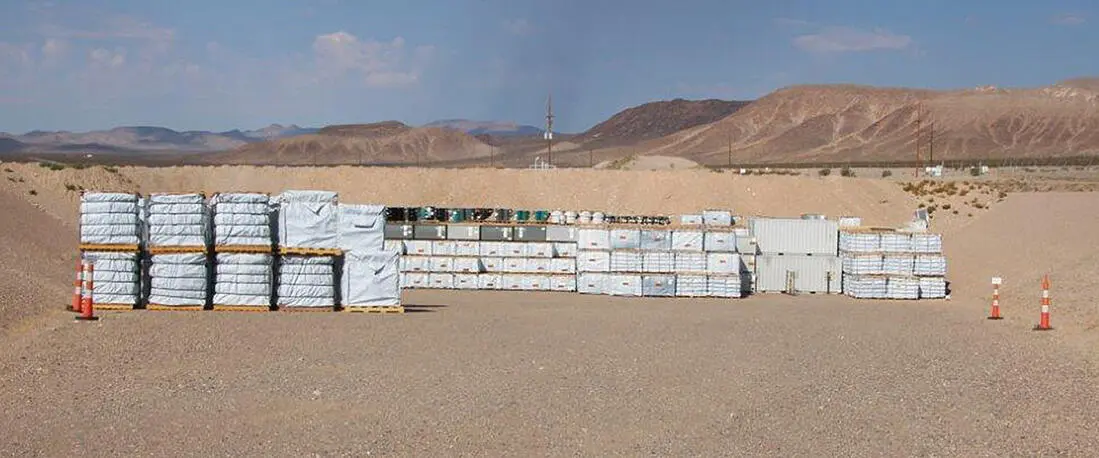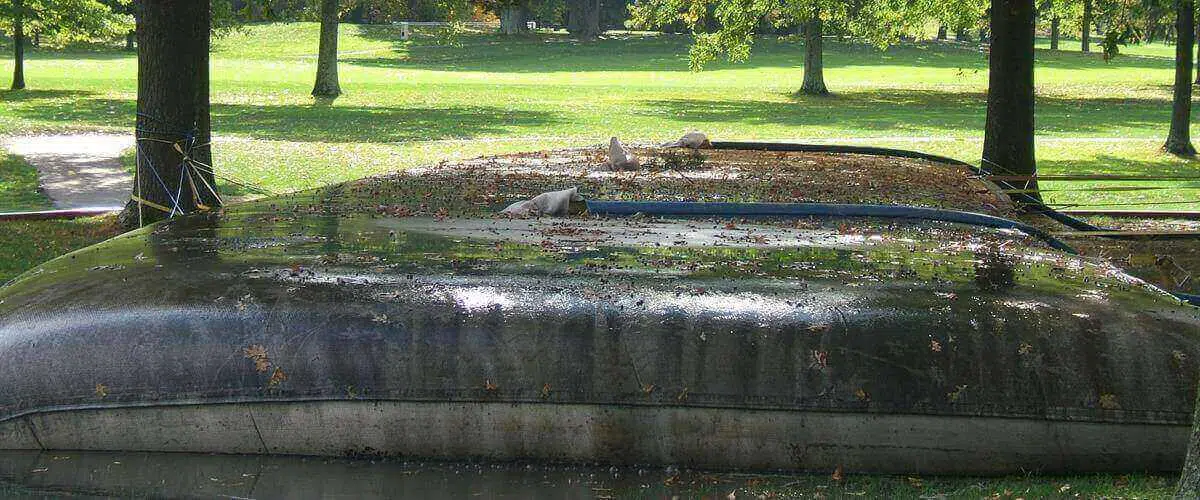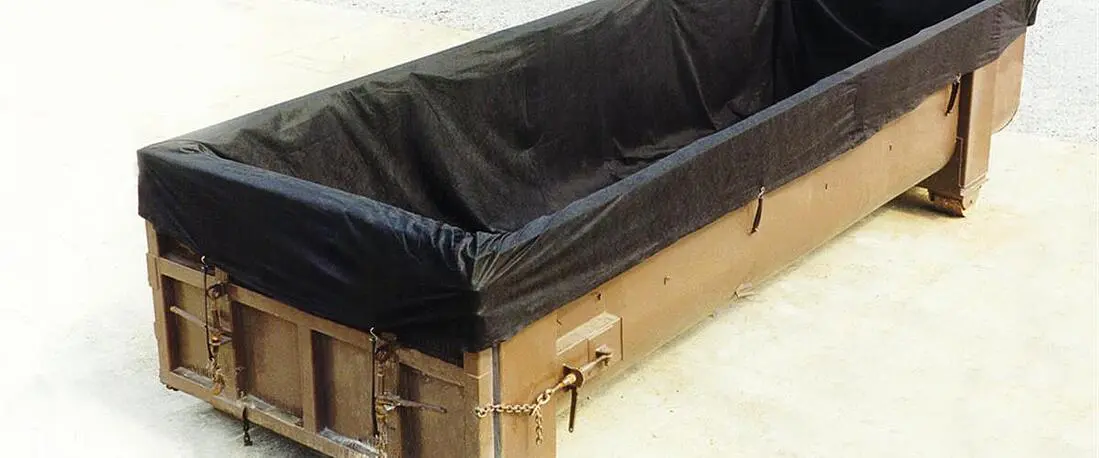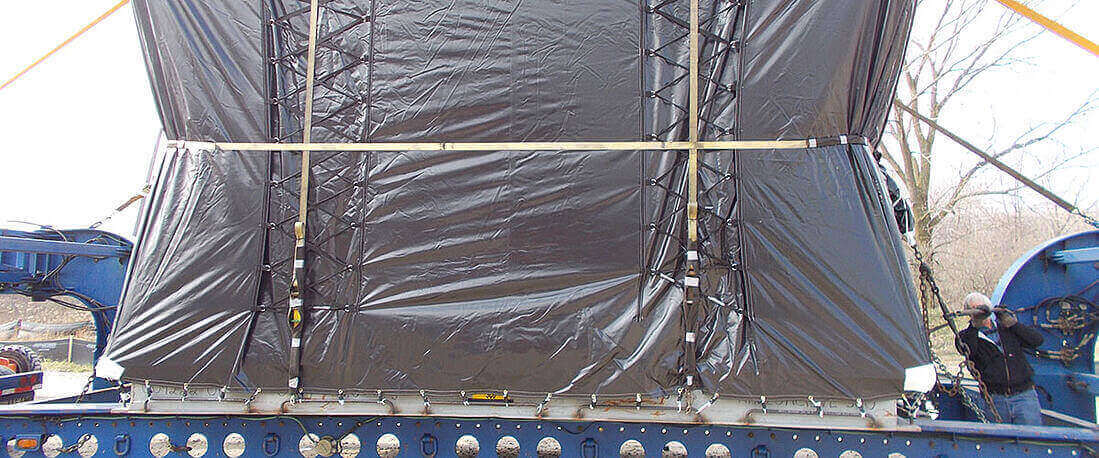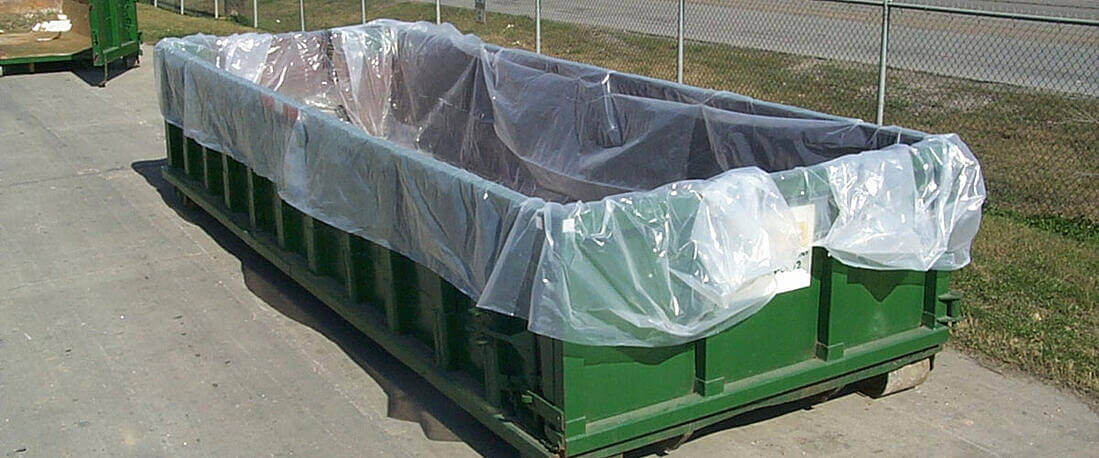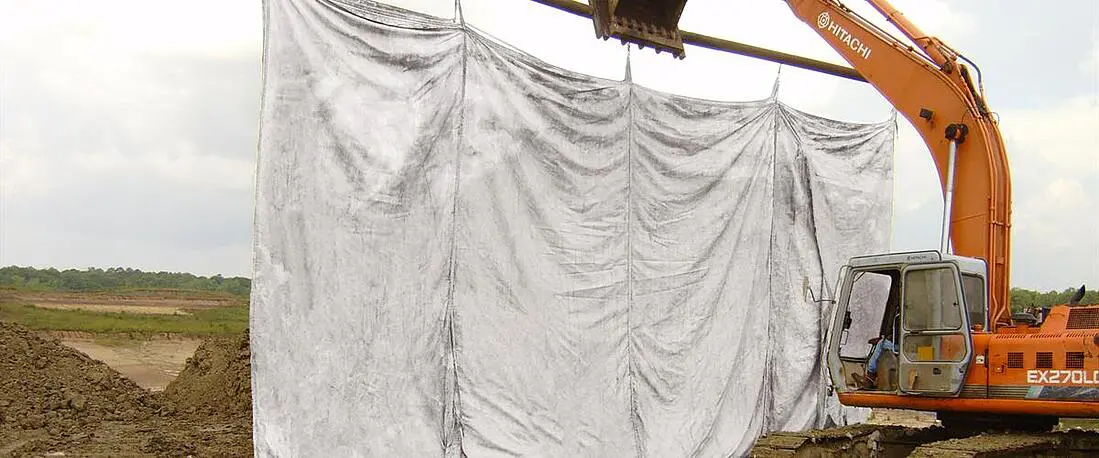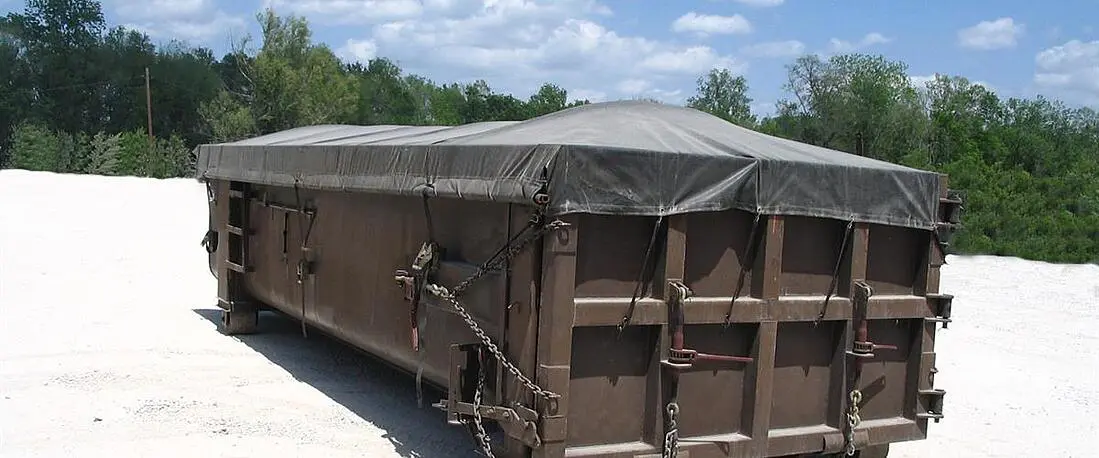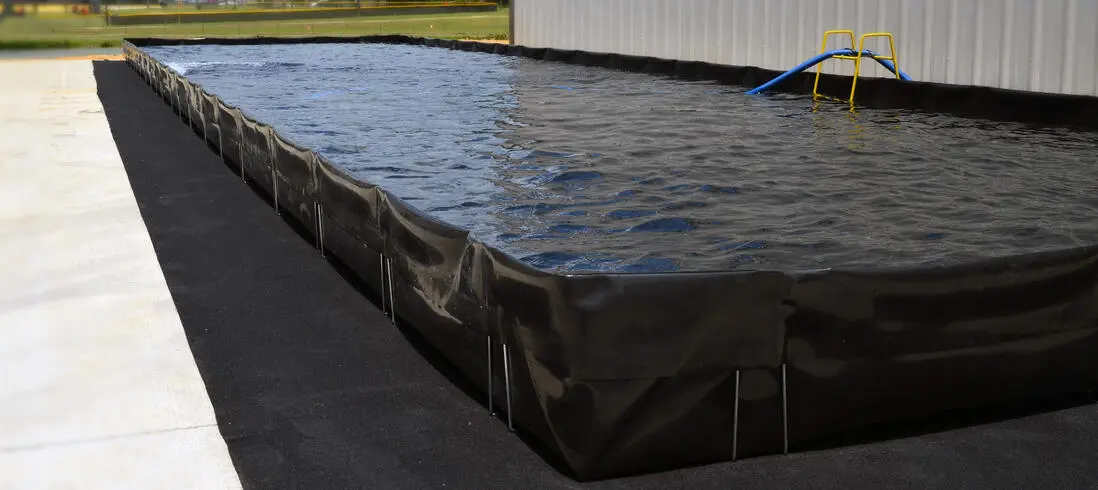Section 1
What is Rigid Waste Packaging?
Rigid containers are just what they sound like. They’re the classic forms of waste packaging you envision: barrels, boxes, and inflexible holders designed to stay in one shape.
The basic concept behind rigid containment solutions is that they aren’t crushable, which means they firmly protect what’s inside. They’re also tear and leak-proof, which makes some users feel safer when storing potentially dangerous substances.
You’ll often see rigid packaging services used at nuclear sites or areas dealing with high-level, potentially radioactive waste. In these cases, spill containment and prevention methods are essential. This makes people more prone to choose stiff, inflexible options.
Rigid industrial waste packaging often comes in the form of:
- A plastic drum barrel
- Dry cask storage
- A 55-gallon barrel, typically made of metal or plastic
Our customers have experienced some real setbacks from using inflexible packaging. That’s why we want to weigh both the pros and cons of rigid packaging options.
Avoid limitations created by rigid packaging. Read on to hear about flexible options.
Section 2
Pros and Cons of Rigid Waste
Packaging
Pros:
-
Superior Strength
When you’re using metal or plastic biohazard waste containers, you’re not really worried about them falling apart over time. Overall, rigid containers offer excellent protection for their contents and are generally perceived as “stronger” than most flexible options.
-
Heat Protection
When dealing with high-temperature waste, rigid waste packaging solutions are commonly designed to withstand melting or burning. Depending on the waste you are disposing of, rigid packaging might be the ideal solution.
-
Stackable
Due to rigid containers having firm edges and shapes, they can be easily stacked for transportation or storage. This solution often appeals to users who plan to keep the waste in a certain location for long periods of time.
-
Easily Recyclable
Recycling drum barrels is actually quite easy and encouraged by state and federal agencies – which is a huge pro of rigid waste packaging solutions. Some organizations will even reuse these drums to conserve natural resources. If not, they can be used for scrap metal.
Cons:
-
Expensive
Not only do you have to pay higher upfront costs of rigid packaging services, but you are also responsible for handling and shipping fees. These costs can be significant due to the weight and stiffness of rigid options.
-
Not Customizable
When you work with a rigid waste packaging solution, what you see is pretty much what you get. It’s difficult (and in most cases impossible) to customize most kinds of inflexible waste containers.
-
Very Heavy
Rigid containers are often extremely heavy when empty, especially when made of thick plastic or metal. Think about dealing with them full of waste. You’ll need to have the right machinery and/or manpower to lift and transport rigid containers. This becomes more of a challenge in remote work sites or locations that make equipment delivery costly.
For example, a 55-gallon barrel typically weighs around 26.5 pounds when empty. Add in heavy contents and you’re looking at extremely hard-to-lift rigid containers. -
Not Collapsible
Although we just shared rigid containers’ sturdiness as a pro when it comes to stacking, one of the biggest drawbacks is they are not collapsible.
When not in use, rigid containers still take up as much room as they do when they’re full. If you don’t think you can find room for a 55-gallon waste container, you might be better off choosing something that can flatten.
Even after you’re finished using your containers, they have to go somewhere. If you can’t store them, they’ll consume plenty of space in any landfill, too.
-
Significantly Higher Carbon Footprint
Lastly, but arguably most importantly, rigid industrial waste packaging options tend to leave a substantial carbon footprint.
Even though you can recycle them, they have a detrimental effect on the environment simply because they increase transportation and fuel requirements. Moving big, sturdy containers from one place to another requires a lot of gas and therefore produces more carbon emissions.
Avoid limitations created by rigid packaging. Read on to hear about flexible options.
Section 3
Types of Waste Best Suited for Rigid Packaging
As we pointed out before, there are some situations in which rigid waste containers are ideal. Let’s take a look at the kinds of waste that are best suited for firm, inflexible storage options.
Radioactive Materials
Radioactive waste, the byproduct of many nuclear technology processes, requires rigid industrial waste packaging options for safe transportation. Effective hazardous waste containers prevent radioactive materials from harming or affecting nearby people, animals, and the environment.
LLW (Low-Level Waste)
As defined by the NRC, “Low-level waste includes items that have become contaminated with radioactive material or have become radioactive through exposure to neutron radiation.” This typically includes contaminated clothing items, rags, mops, filters, tools, etc.
Large Solid Objects from Demolition
A rigid solid waste container is typically required for big chunks of debris created when bridges, roads, and buildings are destroyed. In previous cases, the EPA has found that rigid, wheeled containers are easiest to use for shipping and receiving demolition debris.
ILW (Intermediate Level Waste)
This kind of radioactive waste includes irradiated hulls and end-pieces. These have been heavily irradiated after years in the reactor, and they must therefore be handled with care.
Often, this waste is created when nuclear power plants are decommissioned. The recommendation is typically to use proven techniques and equipment – often rigid containers that people consider to be reliable and sturdy.
They need to be sent to a technological waste reduction facility – safely. Rigid biohazard waste containers help with that.
Spent Nuclear Fuel
Spent nuclear fuel is the fuel that has been irradiated in a nuclear reactor – typically at a nuclear power plant. When these fuel rods are no longer usable (or “spent”) they must be removed and transported via safe hazardous waste disposal tactics.
Solid Radioactive Wastes
Radiation can embed itself into grout or mortar, creating a solid kind of radioactive waste. Typically, rigid hazardous waste transporters and/or toxic waste containers are used to handle heavy, bulky radioactive waste like this.
Avoid limitations created by rigid packaging. Read on to hear about flexible options.
Section 4
Costs Associated with Rigid Packaging
Before we get into the details of flexible packaging, let’s talk about pricing.
It’s important to understand the various costs that contribute to the expense of using rigid containers.
-
Packaging + Lifting
If you’re planning to use a rigid waste packaging solution, you must first factor in the cost of the actual disposal products themselves. Prices vary widely across geographic areas, but we can tell you that lifting rigid containers costs significantly more.
-
Storing
As previously mentioned, solid waste packaging options aren’t collapsible. This means they take up a great deal of floor space at your site – which can be inconvenient or cause you to rent space elsewhere to stage them before use. Storing items like spent nuclear fuel can cost as much as $300,000 a year.
-
Transportation
Even without any waste inside of them, non-flexible containers are quite heavy – especially when made of materials like metal. You’ll find that transporting them, empty or not, is fairly expensive.
Prepare to spend a large amount on fuel with rigid containers that weigh hundreds of pounds. The heavier the vehicle becomes, the greater the inertia is, which means you need more power – and fuel – to keep things moving.
-
Man-Power
Heavy, difficult-to-carry containers usually force you to acquire more manpower to get the job done. Be sure you factor in the price of hiring competent workers when creating your waste management budget. Highly skilled and trained professionals command a higher wage and per diem.
-
Machine-Power
Oftentimes, rigid industrial waste packaging requires the use of heavy machinery. That means paying for forklifts, cranes, and other items that are necessary for moving heavy loads around, as well as the people who operate the machinery. It’s much easier for you to deal with a 50 lb. flexible package than a bunch of 150 lb. barrels – with or without the use of extra equipment.
Those are the biggest factors to consider when budgeting to use rigid containers for waste management.
Now, it’s time to talk about our specialty: flexible waste packaging solutions.
How does it compare to traditional rigid waste packaging? Let’s find out.
Avoid limitations created by rigid packaging. Read on to hear about flexible options.
Section 5
What is Flexible Waste Packaging?
The concept behind flexible waste containers is multi-faceted:
- Non-rigid containers are more versatile, safer, and easier to use
- Flexible waste packaging is significantly more cost-effective than rigid
- There is a push toward zero-waste packaging solutions
- Innovation is pointing toward a more flexible future
We typically see flexible waste packaging used at construction sites, landfills, oil rigs, and other locations that are concerned about spill containment and safe waste transportation. Flexible containers hold up in extreme circumstances, so rain or snow, heat or cold, different businesses can benefit from using them.
A flexible, custom packaging solution is made from high-strength polymeric materials, often with multiple layers, that can prevent leakage and spills. At PacTec, Inc., we use materials that are UV, chemical, and acid-resistant.
Even though flexible packages may appear less secure than rigid options, the use of innovative materials has allowed us to create non-rigid options that are just as safe and reliable, and have the certifications to back it up.
Still, we aren’t blind to some of the potential drawbacks that come with using flexible packaging instead of rigid. Let’s take a look at both sides of the column so you can fully evaluate which type of container is right for your situation.
Section 6
Pros and Cons of Flexible Waste Packaging
Pros:
-
Cost-Effective
We’re working to create zero-waste packaging solutions that are as affordable as they are eco-friendly. As a result, we can assure you that non-rigid containers will reduce costs.
For example, take our self-standing un-rated bag. It holds the equivalent of four 55-gallon drums, priced ~$40 each. As a result, our bags easily save 50% or more in comparison.
Another example comes from our self-standing IP-1 LiftPac, which can save 400% or more compared to the common alternative of a 96 cubic foot metal box.
Although it is difficult to relay an average savings percentage across industrial/nuclear packaging needs, the savings are almost always greater than 40% when using flexible containers over rigid.
-
Easy to Store
Flexible options are designed to collapse and save space when not in use. Don’t need your waste packaging waste solution for the time being? Fold it up and store it easily.
-
Less Manpower Required
Some of our flexible, custom packaging solutions only require one person to load. The self-supporting materials make it easy to keep the bag open, which means fewer people are required to handle one container at a time.
-
Quick to Deploy and Load
When deploying or loading, flexible containers often require less personnel and machinery. This cuts down on costs and the amount of time spent preparing to transport. But we also offer loading and lifting frames for certain packaging types to make the process more efficient, safer and reduce staffing needs.
-
Saves Time and Money when Transporting
The transportation and logistics costs to receive the empty packaging goes up exponentially with rigid packaging, not to mention the costs once filled with waste.
Metal containers cost a great deal to transport because they are heavy. Flexible packages cost far less to move and store because they weigh a fraction of what their competitor solutions do.
-
Lightweight/Compact
Flexible packaging solutions are made of high-strength, lightweight materials, which means transporting them to a new location (empty or full) is much easier than moving heavy rigid barrels. Typically, empty flexible options weigh less than 50 lbs. – a huge difference compared to rigid items that weigh hundreds of pounds.
-
Better Disposal Volume/Weight
Most waste-disposal facilities charge by total volume or weight, including the weight of the packaging or container. Because flexible packaging itself weighs less than a bulky, rigid container, you’ll see immediate disposal cost-savings.
Additionally, some flexible packaging solutions, like dewatering filters and bags can actually cut down on the total volume of waste you need to dispose of.
-
Reduced Carbon Footprint
As we said, we’re all for eco-friendly developments in the waste management industry. That’s why we love flexible packaging options – they decrease disposal rates, weigh less, and typically require fewer workers to move. That means you’re using less fuel for fewer truckloads and transportation runs.
Did you know that 95% of greenhouse gas emissions come from work trucks? By shuttling fewer loads, and using less gas to take light loads, you’re significantly reducing your carbon footprint.
-
Fewer Safety Risks
Although the safety of any packaging is ultimately determined by the shipper, we consider flexible packaging containers to be safer than rigid for a few reasons.
First of all, since they weigh less while empty, they present less crushing hazard if lifted off the ground. Secondly, they have no sharp or rigid corners that could inadvertently hurt a worker.
Flexible packages do not rust and are affordable to replace, meaning you can easily reduce corrosion that could jeopardize your work environment.
-
Customizable
Dealing with wet wastes? Solid items? Biohazardous materials? It doesn’t matter – customizing flexible packaging solutions to your needs is simple. We do this by adding layers to meet your needs – polymeric liners or absorbents for leak prevention, or woven polymerics to safeguard against punctures and material release. Unlike rigid containers, flexible options allow for brand or job-specific customizations that make waste disposal both easy and highly precise.
Cons:
-
Not Suitable for All Waste Types
Perhaps the biggest drawback that comes with using flexible containers is they can’t handle every kind of industrial or nuclear waste. As we mentioned previously, there are some scenarios in which rigid containers are best suited for transportation needs.
Flexible containers cannot handle:
- Content with high moisture levels (essentially liquids)
- Hot radioactive waste, including hot resin
- High-level nuclear waste
Remember: the liability ultimately lies with the shipper. It’s up to you to use appropriate packaging and stay in compliance with regulations (49 CFR).
-
Not Accepted at All Disposal Sites
Flexible engineered packaging solutions are relatively new to the waste management scene. As a result, some disposal sites still won’t accept them as they’re only set up to handle rigid containers. The good news is that more and more disposal sites are adapting to the future of waste disposal – you just need to check with your disposal site before moving.
-
Sometimes Considered “Too New”
Finally, the last con we’ve noticed is that some “old-school” experts are hesitant to adopt the latest and greatest methods of waste packaging. They’re used to relying solely on rigid containers, and adapting to a new, very different method might throw them off their process.
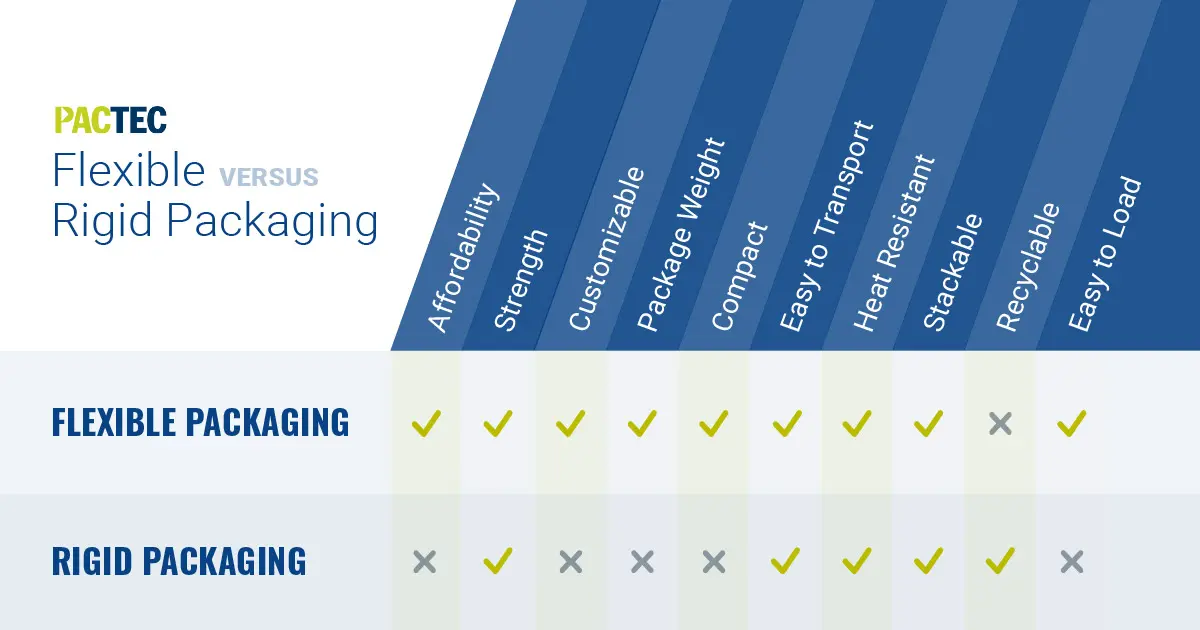
Section 7
Types of Waste Best Suited for Flexible Packaging
Airborne Waste
This includes dust, powder, and other remnants of the waste. Airborne waste can float in the air, invading surrounding areas and even compromising the health and safety of workers. They require special airborne disposal waste tactics.
Flexible waste solutions are designed to contain dust at every stage: generation, transport, and disposal. Their thick, flexible fabrics prevent airborne waste from escaping and allow for very snug fits in containers. Plus, they can be specifically designed with spouts to align with your discharge chutes to eliminate any release while loading.
High Heat
High heat waste, including ash, tar, and other by-products that were produced at high temperatures, require an engineered packaging solution to protect transportation vehicles and workers from the heat.
You might be wondering how a flexible package can handle heat. All of our flexible solutions are crafted from a myriad of materials, some specifically engineered to be fire retardant and withstand extreme temperatures during capture, transport and disposal.
Soil
A flexible packaging solution could be the right fit for construction or agricultural waste, including soil that has come into contact with crops, machinery, and/or livestock.
This kind of soil could be considered hazardous, depending on its source. Fortunately, flexible containment options are created to handle potentially harmful substances with strong walls, durable fabrics, and easy-to-use zipper closures.
Gravel & Flowable Solids
You’ll need a customized packaging solution (preferably flexible) to handle rock, sand, concrete, gravel, brick, asphalt, or asphalt grindings – otherwise referred to as gravel.
Worried that a flexible container can’t handle such tough materials? Don’t be – all of our flexible options are tear-resistant and durable enough to handle rocky gravel.
Demolition Debris
This kind of industrial waste includes, but is not limited to, wood products, roofing materials, plastic pipes, wallboard material, rocks, concrete, bricks, cardboard, and metal like rebar.
All flexible demolition packaging options are created in bright white to reflect for safety purposes. They are DOT compliant, manufactured with tear-resistant fabrics to safely transport heavy-duty debris.
Single Solid Items
There are many items that could be considered “single-solids,” including plastics, leather, munitions, textiles, furniture, and even food. Flexible waste packaging allows you to take care of single solid items in different shapes and sizes.
In many cases, using a flexible container is actually easier than using a rigid one when dealing with single solids. Fabric can form to fit the item perfectly, making your job infinitely simpler.
High Moisture Content Waste
When wet wastes come together to form a “sludge” of sorts, you’ll want dewatering bags and other flexible solutions to deal with the waste. Dewatering bags are designed to act as a strainer that separates the water from the solid waste material. The filtered water can then be drained out, leaving only the solids to be disposed of.
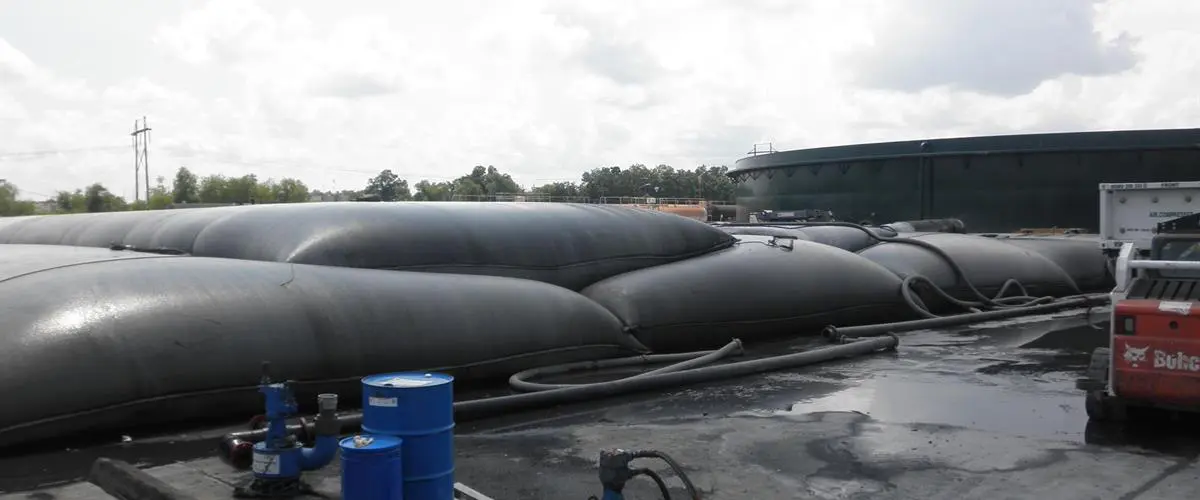
As water is extremely heavy – and disposal costs are calculated by weight – using a flexible dewatering bag can save thousands of dollars.
Although we wouldn’t recommend using flexible containers for true liquids, they are perfectly capable of handling homogeneous solids.
Section 8
Costs Associated with Flexible Packaging
One of the top questions we’re asked is “how much does flexible packaging cost?”
What many don’t realize is that focusing on the initial project cost isn’t always the best way to save money over time. Flexible packaging solutions are often more affordable than rigid options but may appear to cost more upfront. But over time, their safety, quality, and ability to cut down transportation and disposal costs will save you money in the long run.
The cost of a flexible packaging waste solution can vary dramatically. Customizations and additional layers make a big difference.
Get in touch with us and we’ll talk about some of the other factors that influence the base pricing of flexible waste packages.
-
Packaging + Lifting
As with any method of waste packaging, you need to consider how much manual labor you’ll need to pay for once you have the containers or bags. Because flexible packaging is lighter than most rigid options, you might not need to pay as many workers to quickly package and lift waste at a job site.
-
Transportation
It almost always costs less to transport industrial waste in a flexible waste container than it does to move it in rigid containers. Non-flexible packaging weighs more, which increases the amount of gas needed – as well as the number of trips.
Doubling the weight of your containers doubles the amount of energy that your truck needs to exert, therefore resulting in a higher gas bill.
-
Machine-Power
You’ll almost always need heavy machinery to handle industrial waste packaging lifting and loading. However, the loads will still be lighter when using flexible containers instead of rigid ones, meaning you need the machines for shorter periods of time.
You could easily pay hundreds (or thousands) of dollars a day renting all of the machines you need. The less you need to rely on lifting equipment, the more money you’ll pocket.
Section 9
Additional Reasons Flexible Waste Packaging Is the Better Option
In addition to the pros mentioned above, there are many more reasons why flexible waste packaging solutions are the right choice in the majority of scenarios.
IP Testing or UN Rating
UN rated packaging, as well as DOT-compliant packaging, indicates that the containers have been tested to meet extremely high standards for quality and safety. At PacTec, Inc., you can rest assured that all of our options meet applicable DOT guidelines, go through a rigorous quality assurance inspection, and many are IP-certified or UN-rated.
Liquid Content in Waste
When it comes to spill containment and dealing with various wet wastes, flexible solutions are hands-down the best route to take. Our non-rigid liquid packaging solutions are revolutionizing the way industries deal with sludge, wet debris, and more.
Our dewatering filters and bags are designed to separate water from waste to significantly reduce disposal costs. Oftentimes the water can be safely drained into nearby storm drains or waterways or saved for reuse.
Training Required
Teaching workers and team members to deal with flexible waste packaging solutions is simple. Although training takes about the same amount of time as it does with rigid containers, the tasks for set-up, loading, securing, and hauling are more straight-forward.
Packaging Size
A big reason why we typically recommend a flexible customized packaging solution is sizing. Sure, you can purchase rigid packages in different sizes, but you can’t really ask for specific dimensions, collapsibility, or other sizing features.
As a part of our goal to offer zero-waste packaging solutions, we pride ourselves on creating custom flexible packaging options that are made to fit your exact needs and reduce wasted space.
Section 10
Compatible Products Offered by PacTec, Inc.
Now that we’ve tackled the ins and outs of flexible vs rigid waste packaging, let’s take a look at some of the specific products we offer here at PacTec, Inc. You’ll note that they are all flexible options – that’s how strongly we believe in the benefits of non-rigid packaging.
First, our LiftPac® line of waste packaging includes certified IP-1, IP-2 and 7A Type A IP-3 flexible packaging waste solutions. Our clients use them to safely transport a variety of materials – nuclear waste, construction waste, demolition debris, metal items, and much more.
They are even designed to handle homogenous “flowable” solids such as soil and gravel. The package’s non-woven and woven, heavy-duty polymeric material ensures that industrial waste stays safe and secure.
Common Applications for LiftPacs® Include:
- Disposal of flowable solids and liquids
- Metal and wooden box replacements
- Demolition removal
- Safe transportation by rail, flatbed, dump trucks, and barges
Our MacroBag® is a patented packaging solution that is used to fully encapsulate radioactive waste for safe storage, transport and/or disposal.
And although we said rigid containers are often used for hazardous waste disposal, PacTec has pioneered and patented an extremely effective, flexible solution that has been approved for use at several disposal facilities where rigid packages were once exclusively approved.
Common Applications for MacroBags® Include:
- Very low-level mixed waste
- Drum storage
- Radioactive lead solids
- Low level mixed waste
Many of our clients turn to the GeoPac® as a dewatering filter and volume reducer. This product uses pumping pressure to dewater a variety of sludge types. It doesn’t rely on gravity like dewatering box liners, which means it can separate solids from liquids quickly and efficiently.
Common Applications for GeoPacs® Include:
- Agricultural waste dredging
- Municipal sewage plants
- Marine and beach restoration projects
- Industrial pond dredging
Unlike alternative dewatering processes and machinery, our cost-effective dewatering liners utilize gravity to separate liquids from the solids in your sludge or waste stream. They’re easy to install and can significantly reduce your waste volume to save you money.
Common Applications for Dewatering Liners Include:
- Industrial sludge pits
- Cooling tower sludge
- Paint sludge
- Sump cleaning
Made from durable industrial fabrics and a zipper closure system, our NucPac® wraps and overpacks are designed to safely encase bulky or irregular equipment. As always, our packaging services are equipped to customize your solution. Whether you need this to function as a protective wrap for radioactive objects or a cover for dirty machinery, just let us know.
Common Applications for NucPacs® Include:
- Surface-contaminated objects
- Low specific activity material
- Overpacks for non-compliant boxes/drums
Need a method of leak prevention for your big containers?
Our TransLiner® is made from disposable polyethylene material with all seams positioned outside of the container for ultimate leak prevention. No matter what size of container you’re working with, we design liners to fit them all perfectly – every time. This flexible packaging solution also helps with dust and odor control.
Common Applications for TransLiners® Include:
- Roll-off containers
- Rail gondolas
- Luger boxes
- End dump trailers
- Dumpsters
The LandPac® is a flexible waste packaging solution designed to cover large areas, either manually or automatically. It’s often used as a landfill cover, preventing odor and debris from escaping the area and impacting the surrounding environment.
Common Applications for LandPacs® Include:
- Soil remediation
- Replacing daily soil coverage (alternate daily cover)
- Odor control at municipal solid waste landfills
- Coverage at industrial waste landfills
Although rigid containers might be stronger in some senses, we guarantee that our TransCover® is made from extremely high-quality, strong fabrics. We design these tarps to cover the tops of your containers and better protect its contents. Our team can even make a waterproof custom packaging solution, if necessary.
Common Applications for TransCovers® Include:
- Rollover tarps
- Mesh packers
- Compactor tarps
- Auto tarp replacements
- Layflat/throw tarps
Last, but not least, let’s talk about one of our best sellers: a chemical spill containment tray that’s as portable as it is compact. We provide different sizes that can fit in whatever method of transportation you use. Plus, they’re collapsible.
Companies often include BermPacs® in their spill containment kits. The spill tray is designed to catch spilling wet wastes and help with leak prevention and cleanup. It takes mere seconds to set up but can catch plenty of escaping liquid.
Common Applications for BermPacs® Include:
- Protecting fleet rental companies
- Helping with fuel tanker truck spills
- Containing spills from service trucks
- Controlling leaked oil from frac tanks
Conclusion
We might be a little biased, but we can tell you that with almost every case we see at PacTec, flexible packaging wins in terms of convenience, customization, and cost-effectiveness. Rigid containers certainly have their place in industrial work, but that space is becoming smaller as flexible options become more innovative.
Interested in learning more about flexible packaging solutions? Need to design your own customized packaging products?
Get in touch with our PacTec, Inc. team today to learn what we can do for your waste management needs.
